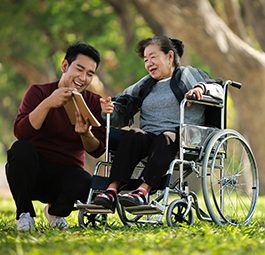Allergies
Tree Pollen Allergy
What Is a Tree Pollen Allergy?
Tree pollen is the cause of most spring pollen allergy symptoms. Tree pollen allergy causes seasonal allergic rhinitis, also called “hay fever.” Pollen from weeds and grasses also trigger allergic rhinitis.
Tree pollen season also often overlaps with grass pollen in the late spring and summer. Throughout the U.S., trees produce the most pollen from February through April. But in some regions, such as the South, trees may produce pollen as early as December or January and peak at multiple times during the year.1
Some trees produce large pollen you can see (a fine, yellow dust that covers outdoor surfaces). This pollen is heavy and falls near the tree. Other trees produce smaller pollen that can’t be seen.
This smaller pollen is light and easy for the wind to carry. Wind-carried pollen is the only type of tree pollen to which most people are sensitive. Because of this, it can easily find its way into your eyes, nose, and lungs. When that happens, tree pollen triggers the symptoms of allergic rhinitis.
How Do I Know If I Have a Tree Pollen Allergy?
Seasonal allergic rhinitis is very common. Around 81 million people in the U.S. have seasonal allergic rhinitis.2,3 Talk with your doctor about your symptoms. If they think you have allergic rhinitis, they will likely recommend allergy treatment. If your symptoms do not improve, ask for a referral to a board-certified allergist.
An allergist can diagnose a tree pollen allergy. They will ask about your personal and medical history, do a physical exam, and run tests to find out the types of trees you are allergic to. Allergists know how to interpret the test results to give you an accurate diagnosis.
What Are the Symptoms of a Tree Pollen Allergy?
If you have a tree pollen allergy, you will only have symptoms when the pollen that you are allergic to is in the air. Symptoms of allergic rhinitis include:
- Runny nose (also known as rhinorrhea – usually a clear, thin nasal discharge)
- Stuffy nose (due to blockage or nasal congestion)
- Postnasal drip (mucus runs from the back of your nose down your throat)
- Sneezing
- Itchy nose, eyes, ears, and mouth
- Red and watery eyes
- Swelling around the eyes
- Shortness of breath, coughing, and/or wheezing
If you have asthma and are allergic to tree pollen, you may have allergic asthma. This means tree pollen triggers your asthma symptoms.
A tree pollen allergy can also cause you to have itching or swelling in or around your mouth when you eat certain foods. This is called pollen-food allergy syndrome (PFAS), also called oral allergy syndrome (OAS). (It can happen to people allergic to some grasses or weeds as well.)
What Is Pollen-Food Allergy Syndrome?
If you are allergic to certain trees, such as birch or alder tree pollen, you may react to certain foods.
PFAS happens because some tree pollen is similar to the protein in some fruits, vegetables, and nuts.4 Your immune system gets confused and can’t tell the difference between them. Eating these foods may cause your mouth, lips, tongue, and throat to itch or swell.
You may be able to eat foods that cause PFAS symptoms if you remove their skins and/or cook them. Heat affects the proteins (breaks them down), so you may be able to eat these foods cooked instead of raw. For example, a fresh tomato may cause symptoms, but a person with PFAS may be able to eat cooked marinara sauce or ketchup without symptoms.
Birch tree pollen can cross-react with:
|
|
Alder tree pollen can cross-react with:
- Almond
- Apple
- Celery
- Cherry
- Hazelnut
- Peach
- Pear
- Parsley
Talk with an allergist if you think you have PFAS. Ask them:
- If you need allergy testing or any other tests to help diagnose it
- If you should avoid eating foods that cause symptoms
- To give you a written allergy treatment plan and to guide you on what medicines to use
- When to follow up with your doctor
What Types of Trees Cause the Most Allergy Symptoms?
Some of the trees that cause the most allergy symptoms throughout the United States are:5
- Alder
- Found in every state except Nebraska and South Dakota
- A common cause of PFAS
- Ash
- Mostly found in Eastern and Southeastern states, but can be found in most states except Alaska and Hawaii
- Very allergenic
- Aspen
- Found in every state except Hawaii
- Related to cottonwood and poplar
- Beech
- Found in the Northeast, Eastern Midwest, and the South
- Birch
- Found in every state except Hawaii
- A common cause of PFAS
- Box elder
- Found in every state except Alaska and Hawaii
- A type of maple that is very allergenic
- Cedar
- Found in coastal states in both the Eastern and Western United States and Oklahoma
- Related to juniper
- Cottonwood
- Found in every state except Hawaii
- Related to aspen and poplar
- Elm
- Found in every state except Alaska, Colorado, Hawaii, Montana, and Wyoming
- Hickory
- Found in the Midwest, Northeast, and Southeast
- Very allergenic
- Juniper
- Found in every state except Alaska and Hawaii
- Related to cedar
- Maple
- Found in every state except Alaska and Hawaii
- Mulberry
- Found in every state except Alaska and Nevada
- Very allergenic
- Oak
- Found in every state except Alaska and Hawaii
- Very allergenic
- Olive
- Found in every state except Alaska and Hawaii
- Pecan
- Found in the Midwest, Northeast, and Southeast, as well as California and Arizona
- Very allergenic
- Poplar
- Found in every state except Hawaii
- Related to aspen and cottonwood
- Walnut
- Found in every state except Alaska, Arizona, Colorado, Hawaii, Idaho, Washington, Nevada, Oregon, and Utah
- Very allergenic
- Willow
- Found in every state except Alaska and Hawaii
- Very allergenic
What Is Cedar Fever?
If you have seasonal allergy symptoms in the winter and live in certain South and Southwestern states, you may have cedar fever.
Cedar fever is when you have an allergic reaction to the pollen of mountain cedar and juniper trees. This allergic reaction causes allergic rhinitis. Even though “fever” is in name, it is not a contagious illness or virus that causes a fever.
Cedar fever is the most common December through February in the following states:
- Arizona
- Missouri
- New Mexico
- Oklahoma
- Texas
What makes cedar fever different is that cold weather triggers cedar and juniper trees to release pollen. After a cold front, the pollen cones on the trees will open at the same time. There is so much pollen that it makes the trees look like smoke is coming off of them.6
Cedar fever is diagnosed and treated the same way as other tree pollen allergies.
Are Tree Pollen Counts Getting Worse?
Trees are effective tools at helping regulate climate. Many trees are monoecious, which means they have pollinating flowers and fruit-, seed-, and nut-bearing flowers on the same plant. But there are some fruit-, seed-, and nut-bearing trees that do not release pollen. These are called “female” trees. These trees rely on small animals and insects to transfer pollen. Other trees release pollen but do not produce fruit, seeds, or nuts. These are called “male” trees. They rely on the wind to carry pollen to other trees for pollination.
More wind-pollinating trees can lead to increased pollen production. Since 1990, pollen seasons have 21% more pollen. Tree pollen levels saw bigger increases than grass or weed pollen.7 “Botanical sexism” (the preference to plant “male” trees) may be partly to blame for the increase in tree pollen. Historically, many urban planners have chosen wind-pollinating (“male”) trees instead of fruiting (“female”) trees when designing communities, streets, and parks. This practice leads to more pollen in cities. Experts believe this is part of the reason why pollen counts have been increasing.8
Diversifying the types of trees in parks and urban areas may help reduce the amount of pollen in the air. Planting more female trees may help regulate surface temperature while also reducing the amount of pollen in nearby areas.
What Is the Treatment for Tree Pollen Allergy?
It’s helpful to know what types of trees you are allergic to. You can reduce your exposure to the trees you are allergic to by watching pollen reports for your area. You can also learn what time of year tree pollen starts to appear in your area so you can start allergy treatment before it begins for better relief during the season.
Here are some steps to managing your tree pollen allergy:
1. Track the tree pollen count for your area. The news media often reports the count for your area, especially when pollen is high. You also can get your area’s pollen counts from the American Academy of Allergy, Asthma & Immunology’s (AAAAI) National Allergy Bureau.
2. Stay indoors in central air conditioning when the pollen count is high, if possible. Keep your windows in your house and car closed too, if possible. Get a Certified Asthma & Allergy Friendly® air filter and/or HEPA filter for your air conditioner.
3. Prevent pollen from coming into your home. If you spend a lot of time outside during peak pollen time:
- Take your shoes off outside
- Don’t wear your “outside” clothes to bed
- Cover your hair when outside or wash it at night
- Wipe off pets before they enter your home
- Shower after coming inside your home after being outdoors for a long time
- Keep windows closed, if possible, during pollen season or peak pollen times.
- Dry your clothes in a clothes dryer or on an indoor rack, not on an outdoor line.
4. Take allergy medicines and start treatment before tree pollen season starts in your area. Find out what time of year tree pollen starts to appear in your area so you can start allergy treatment at least 2 weeks before pollen season begins. Many over-the-counter medicines work well to control pollen allergy symptoms. They can also help eye, nose, and airway symptoms.
5. Talk with an allergist about immunotherapy. There are two types: allergy shots and sublingual immunotherapy (SLIT). This type of treatment may help give you long-term relief. If you have allergic asthma, your Asthma Action Plan may include some of these allergy treatments to help you keep your asthma under control.
Allergy Medicine Guide
Nasal rinse: Using a saline (saltwater) nose rinse can help cut down mucus and rinse allergens out of your nose. Remember to use these as directed.
Corticosteroid nasal sprays reduce inflammation (swelling) in the nose and block allergic reactions. They are the most effective medicine type for allergic rhinitis because they can reduce all symptoms, including nasal congestion. They can also provide some relief for eye allergy symptoms. Nasal corticosteroids have few side effects (e.g., headache, nose bleeds or irritation).
Corticosteroid nasal sprays: FLONASE®, Nasacort®, Nasonex™, Nasalide/Flunisolide, Omnaris™, QNASL®, RHINOCORT®
Antihistamines relieve sneezing and itching in the nose and eyes. They also reduce a runny nose and, to a lesser extent, nasal stuffiness. Look for a long-acting, non-drowsy antihistamine. The newer medicines do not carry the risk of toxicity and death that has been associated with older antihistamines like diphenhydramine.
Non-steroidal antihistamine nasal sprays (may cause drowsiness): Astelin®, Astepro®, Patanase®
Non-drowsy oral antihistamines: Allegra®, CLARINEX®, Claritin®
Oral antihistamines that may cause drowsiness in some individuals: Xyzal®, ZYRTEC®
Cetirizine (ZYRTEC®) and loratadine (Claritin®) are the antihistamines of choice for use during pregnancy. They have established safety profiles and are effective in treating allergy symptoms during pregnancy.
Diphenhydramine and related short-acting antihistamines (like promethazine) should be avoided. Diphenhydramine (known under the brand name BENADRYL®) is not a good choice to take for allergy symptoms because of its short-term action to manage symptoms and several known negative side effects. The major side effects of diphenhydramine and older generation antihistamines include drowsiness, sedation, dry mouth/eyes, and fatigue. This can also impair alertness, concentration, multitasking, and memory. In turn, this antihistamine can affect important functions, such as learning and test performance in children, as well as operation of machinery and cars in adults. As these medicines can impair you, they can affect work performance and safety.
Eye drops: Allergy eye drops can relieve eye burning, itchiness, redness, increased tearing, and swelling.
Antihistamine eye drops: Azelastine/Optivar, Bepreve®, Elestat®, LASTACAFT®, Opcon-A®, Systane® ZADITOR®, Patanol™, and Pataday®
Decongestants help shrink the lining of the nasal passages and relieve nasal stuffiness. They generally are only used for a short time (3 days). Read the instructions carefully and do not use them for extended amounts of time. Extended use of decongestant nasal sprays can cause a rebound effect that worsens your congestion. Make sure you talk with your doctor about the appropriate use of decongestants, limitations, and potential side effects.
Nasal spray decongestants: Afrin®, Vicks Sinex™
Oral decongestants: SUDAFED®
Some allergy medicines combine an antihistamine with a decongestant. Certain types of combo medicines (such as the ones that contain pseudoephedrine as the decongestant) are available “behind the counter”. Behind-the-counter products are available without a prescription but have limitations on purchases due to state and federal laws. Talking with pharmacy staff is generally necessary to obtain these types of allergy medications.
Decongestant + antihistamine combos: Allegra-D®, Claritin-D®, Clarinex-D, ZYRTEC-D®
Check with your doctor before using decongestants if you have high blood pressure, heart disease, glaucoma, thyroid disease, or trouble urinating. They may cause issues if you have any of these conditions and they may interact with other prescription medicines.
Federal Regulations on Decongestants
The oral form of phenylephrine (PE) is a common active ingredient in many OTC decongestants. An expert panel of the FDA reviewed studies which showed oral PE is not effective at relieving nasal congestion in commonly used doses. The FDA is proposing to end use of oral PE. This would remove these products from the U.S. market. The change would not affect the nasal spray forms of PE.
Decongestants that contain pseudoephedrine (PSE) require photo identification and are only available to purchase behind the pharmacy counter.
Cromolyn sodium is a nasal spray that blocks your body from releasing chemicals (such as histamine and leukotrienes) that cause allergy symptomsincluding histamine and leukotrienes. This medicine has few side effects, but you must take it three to six times a day. For optimal results, this medication should be used daily during your allergy season. It can be started up to one week before your allergy season begins.
Cromolyn sodium nasal spray: NasalCrom®
Leukotriene receptor antagonists (or modifiers) block the action of important chemical messengers (other than histamine) that are involved in allergic reactions. These medicines help manage asthma and allergic rhinitis symptoms. These medications are taken orally. How often you take them depends on the specific drug. Discuss the appropriate use of these medications with your doctor, including the risks and benefits of therapy.
Options include: ACCOLATE®, SINGULAIR®*, Zyflo CR®
*Note: Montelukast (brand name SINGULAIR®) has a black box warning because it can cause serious mental health side effects. This is a safety warning from the Food and Drug Administration (FDA). This means you need to be aware of a drug’s side effects or important instructions for safe use of the drug. We encourage you to speak with your health care provider before, during, and after the start of any new medicine. If your doctor recommends montelukast, talk with them about possible risks and concerns.
Medical Review: March 2025 by John James, MD
Should I Move to Get Relief from My Tree Pollen Allergy?
Trees that produce allergenic pollen grow in every state. Tree pollen also spreads easily through the air, so you may be exposed to pollen of trees not on your property. If you move, you may get some relief for a short time. But you can develop allergies to the trees in your new location in a few years. Instead, work with an allergist on a solid allergy treatment plan.
closed
References
- Lo, F., Bitz, C.M., Battisti, D.S. et al.Pollen calendars and maps of allergenic pollen in North America. Aerobiologia 35, 613–633 (2019). https://doi.org/10.1007/s10453-019-09601-2
- Ng, A.E. & Boersma, P. (2023). NCHS Data Brief, no 460: Diagnosed allergic conditions in adults: United States, 2021. National Center for Health Statistics. https://dx.doi.org/10.15620/cdc:122809
- Zablotsky, B., Black, L.I., & Akinbami, L.J.(2023).NCHS Data Brief, no 459: Diagnosed allergic conditions in children aged 0-17 years: United States
- Oral Allergy Syndrome Symptoms, Diagnosis & Treatment | AAAAI. (2024, January 10). American Academy of Allergy, Asthma & Immunology. https://www.aaaai.org/Tools-for-the-Public/Conditions-Library/Allergies/Oral-allergy-syndrome-(OAS)
- Tree and Plant Allergy Info for Research – Allergen and Botanic Reference Library. (n.d.). www.pollenlibrary.com. Retrieved July 30, 2024, from https://www.pollenlibrary.com/
- Cedar Fever – Explained. (n.d.). Texas A&M Forest Service. Retrieved February 12, 2025, from https://tfsweb.tamu.edu/content/article.aspx?id=31295
- Climate Central. (2023). Seasonal allergies: pollen and mold. https://assets.ctfassets.net/cxgxgstp8r5d/6HEq6ZLb0QpvXxScvaM7sc/ae3024a9c4f2bcdd9b563d09b1bd07c3/FINALSeasonal_allergies_pollen_and_mold_2023__EN_.pdf
- Ogren, T. L. (2015, April 29). Botanical Sexism Cultivates Home-Grown Allergies. Scientific American Blog Network. https://blogs.scientificamerican.com/guest-blog/botanical-sexism-cultivates-homegrown-allergies/
Medical Review: August 2024 by Mitchell Grayson, MD; “What Is Cedar Fever?” reviewed February 2025 by Miriam Anand, MD
Allergy Capitals
Your location can have an impact on your seasonal allergies. AAFA’s Allergy Capitals™ report looks at the top 100 most challenging cities in the continental United States to live with seasonal pollen allergies.














